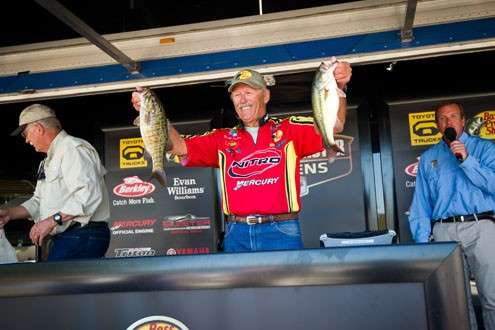
Tommy Martin got an early and expensive lesson on the art of flippin’ from none other than the man who invented the technique, Dee Thomas.
It was early April 1975, and Thomas had just won the B.A.S.S. Arkansas Invitational on Bull Shoals Lake with a new method that few outside the California Delta area had ever seen or heard of. He used a long rod, heavy line and hair jig to beat the best touring pros in the business.
It was a brutally tough tournament. Over three days and despite a 10-bass daily creel limit, Thomas managed just 35 pounds, 6 ounces of bass, but it was more than enough to win. Second place was almost 10 pounds behind with 25-10. First place paid only about $3,500, but second place was a lot less.
Second place was Tommy Martin.
“It was an eye-opening experience,” Martin says of watching the flippin’ technique debut on a national stage. “We all know how flippin’ has come to play a part in every serious bass angler’s arsenal, and it really started right there.”
In a career of more than 40 years, Martin has seen a lot of techniques come and go and accomplished a great deal, including winning the 1974 GEICO Bassmaster Classic, qualifying for 19 Classics and finishing in the top 10 of the Toyota Bassmaster Angler of the Year race 10 times. He’s one of the sport’s all-time greats.
And Martin never launches his boat without several flippin’ rods on board. It’s a go-to technique for him at some point in all four seasons, but every season demands a different approach, and that includes summer.
Here are five tips that get Martin more and bigger bass with the long rod come summertime.
1. Stay “outside.”
In spring and fall, it’s common to find bass back in the creeks and coves, spawning or chasing baitfish. But in the summer, you’ll do much better to focus your efforts on main lake structure and cover.
“Banks with 5 feet of water or more on them are best,” Martin says. “Bass will be around the edges of brush and boat docks early, but back under the shade in the darkest, coolest water once the sun gets up. That’s when flippin’ and pitching really come in handy.”
2. Go heavy.
The bass’ metabolism is in high gear when temperatures are warm in the summer. Instead of a subtle, slower presentation that works well in the winter, Martin triggers a reaction bite by opting for heavier jigs or sinkers in summer.
“I like a Bass Pro Shops XPS tungsten sinker that weighs 3/4- or even a full ounce in summer,” he says. “It gives your bait a really fast fall that the bass has to react to — there’s no thinking about the bait or examining it, instinct takes over. I get a lot more bites with a heavy sinker. You might get hung up in wood cover a little more, but the extra bites are worth it.”
3. Try a lizard.
“My favorite summertime flippin’ bait is an 8-inch Zoom Lizard in blue fleck. It’s great in dark, murky water, has a lot of action and looks like a big meal.”
Martin points out that a lot of flippers and pitchers opt for beaver-style baits in warm weather because the penetrate matted vegetation well. But a lot of his summertime fishing is done around woody cover and boat docks where a streamlined or compact bait is not critical.
“The lizard is great in brush,” he says. “I sometimes fish it behind a punch skirt to make it appear even bulkier. If the cover’s a little too heavy for the lizard, I’ll go to a bait with a slightly smaller profile like the Zoom Big Critter Craw.”
4. Smelly is good.
Competitive anglers want every edge, and Martin is no exception. He likes to spray his summertime flippin’ and pitching baits with garlic scent periodically throughout the day. He’s not sure whether the garlic acts as an attractant or whether it merely masks human odor, but he is sure it gets him more bites … or at leaves gives him more confidence.
5. The right stuff.
When you’re fishing heavy cover, line size means more to most anglers than it does to the bass. They typically don’t see it in the tangles and shade where they make their homes. As a result, Martin isn’t shy about his choice.
“I use 65-pound-test braided line with about an 18-inch leader of 25-pound-test Bass Pro Shops XPS Fluorocarbon that I connect with a double-reverse Albright knot. I think I get more strikes because of the fluorocarbon leader, but I need the heavy braid to get in the cover without having to retie all the time.”
Martin’s reel is a Bass Pro Shops Johnny Morris Signature Series model (7:1 gear ratio) which he clamps to a new Tommy Martin Signature Series rod from McCain Hi-Performance Graphite Rods. The 7-foot, 3-inch rod can wrest big bass from the thickest tangles.
Martin’s hook might surprise you. It’s not a giant wide gap model like so many anglers use when flippin’ and pitching.
“I like a 3/0 Lazer TroKar Flippin’ Hook,” he says. “It has a cutting edge that penetrates very easily, and by going with a slightly smaller size I avoid hang-ups without losing fish.”
When Tommy Martin got his first lesson in flippin’, a lot of anglers thought it was only a cool weather technique. Through the years, we’ve learned different. It’s a method for all seasons, and Martin’s tips will help you catch more and bigger bass flippin’ and pitching in summer.





